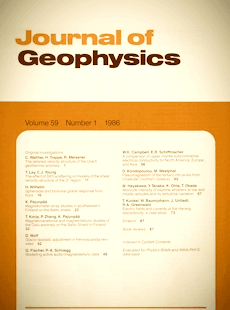Discrete frequency inequalities for magnetotelluric impedances of one-dimensional conductors
Article Sidebar
Published:
Feb 27, 1986
Keywords:
Magnetotellurics,
Inverse problem
Volumes

Vols. 1-18 (1924-1944), ISSN 0044-2801
Main Article Content
P. Weidelt
Institute of Geophysics and Meteorology, Technical University, Braunschweig Germany
Abstract
For the one-dimensional magnetotelluric inverse problem the ties between the impedances at neighbouring frequencies, reflecting the analytical properties of the transfer function, are expressed in terms of inequalities between the data. After the derivation of some elementary necessary constraints for data sets with two or three frequencies, a set of necessary and sufficient conditions warranting the existence of a one-dimensional conductivity model in the general M-frequency case is given. This set of constraints characterizes a 1-D data set by the signs of 2M determinants derived from the data.
 ARK: https://n2t.net/ark:/88439/y087338
ARK: https://n2t.net/ark:/88439/y087338
Permalink: https://geophysicsjournal.com/article/228
Article Details
How to Cite
Section
References
Cagniard, L. (1953) Basic theory of the magneto-tell uric method. Geophysics 18:605-635
Gantmacher, F.R. (1959) The theory of matrices, Vol. II. Chelsea, New York
Parker, R.L. (1972) Inverse theory with grossly inadequate data. Geophys. J. R. Astron. Soc. 29:123-138
Parker, R.L. (1980) The inverse problem of electromagnetic induction: existence and construction of solutions based on incomplete data. J. Geophys. Res. 85:4421-4428
Smirnov, V.I. (1964) A course of higher mathematics. Vol. Ill/1. Pergamon Press, Oxford
Weidelt, P. (1972) The inverse problem of geomagnetic induction. J. Geophys. 38:257-289
Weidelt, P. (1985) Construction of conductance bounds from magnetotelluric impedances. J. Geophys. 57:191-206
Gantmacher, F.R. (1959) The theory of matrices, Vol. II. Chelsea, New York
Parker, R.L. (1972) Inverse theory with grossly inadequate data. Geophys. J. R. Astron. Soc. 29:123-138
Parker, R.L. (1980) The inverse problem of electromagnetic induction: existence and construction of solutions based on incomplete data. J. Geophys. Res. 85:4421-4428
Smirnov, V.I. (1964) A course of higher mathematics. Vol. Ill/1. Pergamon Press, Oxford
Weidelt, P. (1972) The inverse problem of geomagnetic induction. J. Geophys. 38:257-289
Weidelt, P. (1985) Construction of conductance bounds from magnetotelluric impedances. J. Geophys. 57:191-206











